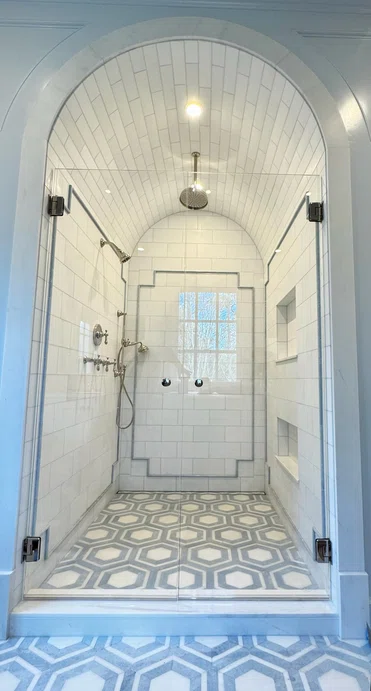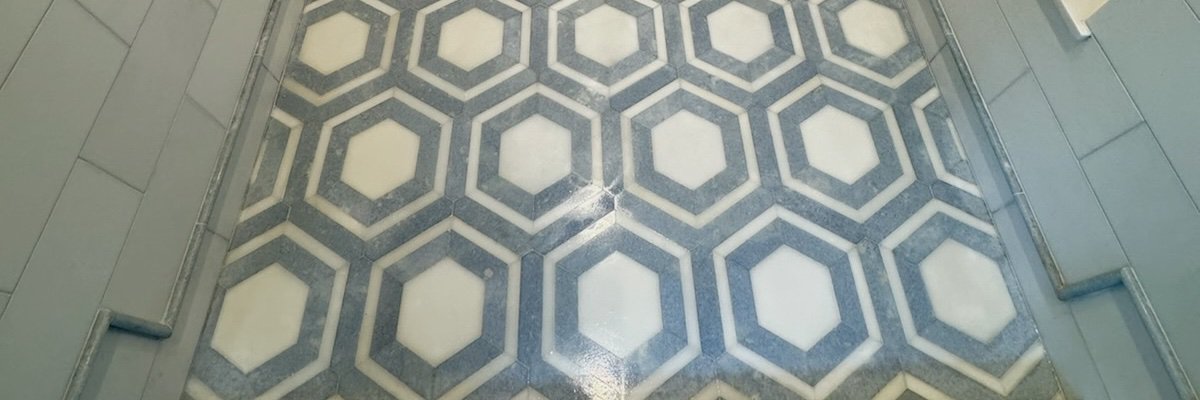

D.W. Sanders Tile & Stone Contracting, Inc., recently won the Grand Prize NTCA Five-Star Residential Project of the Year for its stunning work on the “When White Turns Red” primary bath. The project featured honeycomb multi-color stone mosaic floors, shower cased with marble slabs, plus a Thassos marble barrel ceiling and walls with decorative panels formed out of stone liners in a Greek key configuration.
D.W. Sanders studied the project and brought its understanding of the materials being used, substrates, intended use of the area as well as functional and aesthetic details to bear on the project, resulting in technical sound work for all aspects of the job. The contractor is dedicated to building its assemblies according to TCNA Handbook details and industry best practices, and this project was no exception. Care, thoughtfulness and expertise were applied to the entire bath, with special consideration given to managing the water and how the aesthetic of the work would interact with the slab casing and wood trim. D.W. Sanders chose water-in water-out methods following TCNA F-144 for floor, W-244 for walls and B415 shower floor due to the stone installation.

One early construction detail that the contractor encountered was slab casing and finished height at the spring line in relationship to the door. This was further compounded in a barrel vault situated atop deco panels on all three walls. The solution was to lay out the stone prior to prep so that framing modifications could be made. Once prepped, walls needed to be taped and rendered to plumb.
Prep was completed, layout established, 6”x12” marble sorted for shade, and marble tiles fabricated to keep equal width stone tile throughout the barrel vault. Then it was time for the installation to begin for what should have been a routine install. But that was not to be the case. The next day – as the white marble Thassos tiles were placed – they began to develop red spots within an hour. Initially, D.W. Sanders suspected that the clay had contaminated the water or mortar. Then the stone was examined again to see if something was missed on the back or sides, but none of those suspicions panned out. Finally, a piece was removed and it was determined that the stone contained iron that was activated by the moisture in the thin-set mortar.
Detail of the completed main floor.
The barrel vault was situated atop deco panels on all three walls. The contractor laid out the stone prior to prep so that framing modifications could be made. Once prepped, walls needed to be taped and rendered to plumb.
An unexpected problem ground the installation to a halt as pieces of the Thassos marble started to develop red spots within an hour of installation.
To correct this situation, the contractor stopped the installation and removed that day’s work, cleaned the stone and allowed it to dry overnight. A few unset marble tiles were brought to the office and placed into shallow pans with damp paper towels overnight. The next morning rust appeared in uninstalled marble. The stained Thassos tiles did not fade. D.W. Sanders called several trusted technical outlets and stone suppliers. While not common, these stains can happen depending on the grade of Thassos.
With discovery and industry input, the contractor called the supplier which agreed to replace the marble. The supplier recommended that the replacement stone needed to be dip sealed (six side sealing) for the best outcome. The next step was to determine the best sealer and run a few tests before proceeding.
Once tiles were removed, the new Thassos marble tiles were dip sealed according to supplier recommendations before installation.
With new knowledge in hand, the new lot of Thassos was dip sealed and then installed. Though the project was delayed several weeks with schedules and budget being affected, clear communication to all parties produced a successful project, and the problem is long forgotten due to the final, beautiful results.





